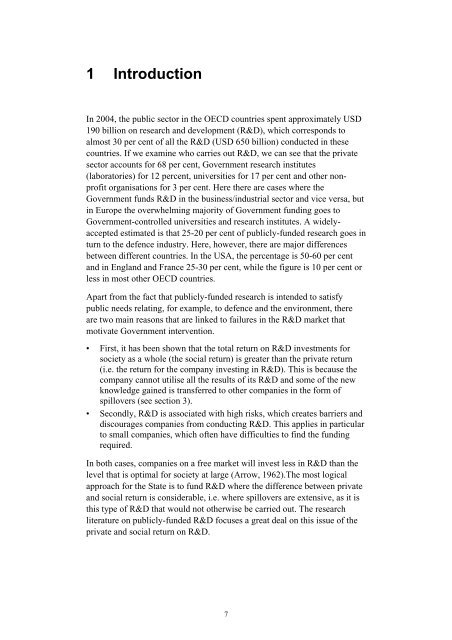Growth through Research and Development - what does ... - Vinnova
Growth through Research and Development - what does ... - Vinnova
Growth through Research and Development - what does ... - Vinnova
Create successful ePaper yourself
Turn your PDF publications into a flip-book with our unique Google optimized e-Paper software.
1 IntroductionIn 2004, the public sector in the OECD countries spent approximately USD190 billion on research <strong>and</strong> development (R&D), which corresponds toalmost 30 per cent of all the R&D (USD 650 billion) conducted in thesecountries. If we examine who carries out R&D, we can see that the privatesector accounts for 68 per cent, Government research institutes(laboratories) for 12 percent, universities for 17 per cent <strong>and</strong> other nonprofitorganisations for 3 per cent. Here there are cases where theGovernment funds R&D in the business/industrial sector <strong>and</strong> vice versa, butin Europe the overwhelming majority of Government funding goes toGovernment-controlled universities <strong>and</strong> research institutes. A widelyacceptedestimated is that 25-20 per cent of publicly-funded research goes inturn to the defence industry. Here, however, there are major differencesbetween different countries. In the USA, the percentage is 50-60 per cent<strong>and</strong> in Engl<strong>and</strong> <strong>and</strong> France 25-30 per cent, while the figure is 10 per cent orless in most other OECD countries.Apart from the fact that publicly-funded research is intended to satisfypublic needs relating, for example, to defence <strong>and</strong> the environment, thereare two main reasons that are linked to failures in the R&D market thatmotivate Government intervention.• First, it has been shown that the total return on R&D investments forsociety as a whole (the social return) is greater than the private return(i.e. the return for the company investing in R&D). This is because thecompany cannot utilise all the results of its R&D <strong>and</strong> some of the newknowledge gained is transferred to other companies in the form ofspillovers (see section 3).• Secondly, R&D is associated with high risks, which creates barriers <strong>and</strong>discourages companies from conducting R&D. This applies in particularto small companies, which often have difficulties to find the fundingrequired.In both cases, companies on a free market will invest less in R&D than thelevel that is optimal for society at large (Arrow, 1962).The most logicalapproach for the State is to fund R&D where the difference between private<strong>and</strong> social return is considerable, i.e. where spillovers are extensive, as it isthis type of R&D that would not otherwise be carried out. The researchliterature on publicly-funded R&D focuses a great deal on this issue of theprivate <strong>and</strong> social return on R&D.7
















